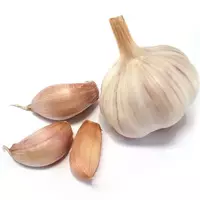Garlic

Central Asia is generally considered the birthplace of garlic, but since ancient times it has been cultivated in many countries, for example, in Egypt and ancient Greece. Many rites and legends among various peoples are associated with garlic. So, in ancient Egypt, workers who built pyramids were forced to eat garlic to maintain health and physical strength. In Europe, garlic was used to treat plague during epidemics. In England, garlic was tied to the feet of smallpox patients, sincerely believing that this would help cure. In ancient Greece and Rome, garlic was used to scare away dark forces and evil spirits. Even nowadays, elderly residents of Greece, China and Israel after the birth of their grandson give him a garlic clove in order to protect the child from the evil eye.
The benefits of garlic
Garlic is thought to be great for nerve disorders. In addition, it slows down aging processes and prolongs life. Such traditions take place, primarily because garlic does not deteriorate for a surprisingly long time and is able to preserve moisture and freshness for months, unlike other vegetables, which lose their appearance after a few hours or days. But rumors about the miraculous properties and unprecedented benefits of garlic are by no means an exaggeration.
The calorie content of garlic with moderate consumption is small. One head contains only 4 calories and is completely free of fats and carbohydrates. Sulfur, which is part of garlic (it is it that gives it a specific aroma) lowers blood pressure, serves to prevent stomach cancer. The smell of garlic has haunted people for many centuries, even great writers pay tribute to it in their works. For example, A. Dumas wrote: "The smell of garlic is perfectly felt by everyone except those who ate it. " But in order to return freshness to breathing, you just need to chew parsley leaves, or cardamom or cinnamon seeds.
Garlic is a natural antibiotic that helps prevent complications caused by colds and flu. Garlic contains a large number of various trace elements - sodium, calcium, potassium, iron, phosphorus, magnesium, etc. In addition, vitamins of group B, C, P, D, phytoncides, essential oils are present in garlic.
Garlic kills a huge number of diverse bacteria. Garlic contains a significant amount of selenium and some other substances related to antioxidants, so garlic has an amazing and invaluable property: it is able to slow down the development and spread of cancer cells in the human body.
Studies have recognized garlic as a very useful addition to the diet, as it is able to reduce cholesterol levels.
The harms of garlic
For all the healthy properties of garlic, it's a pretty toxic vegetable. Sulfides included in its composition can negatively affect human health, causing headaches, distracted attention, slow reaction. In addition, garlic is contraindicated in people with diseases of the gastrointestinal tract and cardiovascular system. The harm of garlic manifests itself in allergic reactions, therefore, with individual intolerance, it should be abandoned.
And the last remark regarding the use of garlic in food - it is recommended to grind it with a knife, and not press it with special presses, while the taste is better manifested and the benefits of garlic - the "king of spices, " according to the apt note of Pythagoras.
garlic 149 kCal
The energy value of garlic (Ratio of proteins, fats, carbohydrates - ju):
Proteins: 6.5 g (~ 26 kCal)
Fats: 0.5 g (~ 5 kCal)
Carbohydrates: 29.9 g (~ 120 kCal)
Energy ratio (b | y): 17% | 3% | 80%
 Español
Español Français
Français Português
Português Русский
Русский 简体中文
简体中文 繁體中文
繁體中文 日本語
日本語 한국어
한국어 العربية
العربية Türkçe
Türkçe Қазақ
Қазақ Deutsch
Deutsch Italiano
Italiano Українська
Українська
